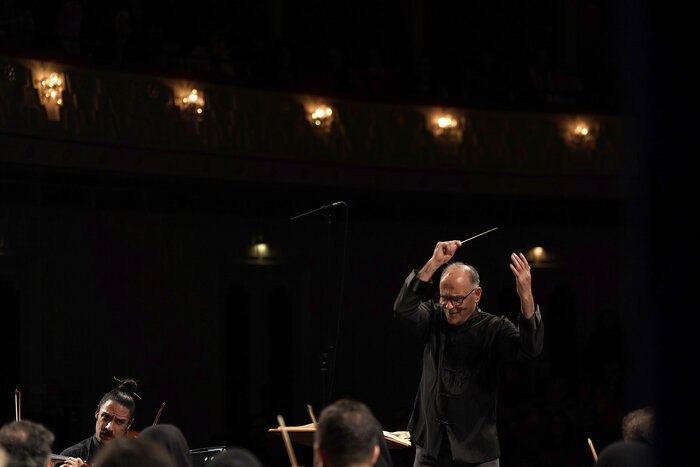
On the fourth day of the Fajr Music Festival, the Tehran Symphony Orchestra, conducted by Nasir Heydarian, took the stage at Vahdat Hall and performed Tchaikovsky’s Symphony No. 5.
This performance, with better coordination of the orchestra compared to previous performances, still reminded of the necessity of appointing a permanent conductor and forward-looking planning for the orchestra.
On the fourth day of the 40th Fajr Music Festival, Vahdat Hall hosted the Tehran Symphony Orchestra at 18:30, conducted by Nasir Heydarian.
This concert was dedicated to the performance of Symphony No. 5 by Pyotr Ilyich Tchaikovsky, the renowned Russian composer.
Tchaikovsky’s Symphony No. 5 is written for a large and diverse orchestra, which includes various groups of wind, string, and percussion instruments:
Movements and Duration
This symphony consists of four movements:
Tchaikovsky proposed the idea of Symphony No. 5 in early 1888 and, despite health issues and numerous travels, worked on it during the summer of that year.
At first, he suffered from doubt and lack of inspiration, but gradually made progress and completed the initial draft by June.
He then began orchestrating the work and completed it in the following months.
Tchaikovsky was also working on the Hamlet Overture at the same time.
Although he was concerned about his compositional abilities, he ultimately managed to complete both works, which are considered among the significant pieces of his late period.
Regarding this performance, from the very beginning of the concert, the Tehran Symphony Orchestra began its work with confidence and acceptable readiness.
The tuning and overall coordination among different sections were acceptable, but in the early sections, the brass instruments sometimes sounded dull and not very clear.
Also, in some moments, noticeable rhythmic inconsistencies were observed between the wind and string sections, which in some parts affected the overall cohesion of the performance.
Nevertheless, gradually — and especially from the middle of the concert onward — the performance became more unified.
The orchestration, particularly in the dialogue between strings and winds, became more coordinated, and the musicians continued their performance with greater focus and confidence.
At this stage, the phrasing became more cohesive, and the orchestral tone found better balance, so that the music had greater expressiveness and dynamic impact.
However, the strings throughout the concert could have performed cleaner and more transparently, especially in parts that required more precision in balance and clarity of sound.
Tchaikovsky’s Symphony No. 5 is especially famous for its attractive horn melody, which plays an important role in conveying the piece’s emotions.
This part was performed by Farshad Sheikhi, but the horn performance in this concert faced challenges.
Dull sounds and rhythmic problems were especially noticeable at the beginning of this section.
Overall, the horn performance in this concert can be considered average.
The Tehran Symphony Orchestra in this concert was able to deliver a more attractive and coordinated performance compared to its previous ones.
Although in some parts the orchestra could have sounded more blended and cleaner, overall, this concert’s performance can be considered more brilliant than the Tehran Symphony Orchestra’s past performances.
Especially considering the evident decline in performances this fall, this performance indicated significant improvement.
An interesting point is that with previous guest conductors, the orchestra had fewer rehearsal sessions for preparing the piece compared to Nasir Heydarian’s leadership.
Nevertheless, the orchestra’s readiness and coordination clearly show that the effect of conducting on the orchestra’s performance is fully evident.
The orchestra had the same musicians, but the only thing that had changed was the conductor, who effectively steered the ship of the Tehran Symphony Orchestra — and this can clearly be seen in the change in sound quality and the orchestra’s greater cohesion.
In this performance, Nasir Heydarian showed confident and masterful conducting.
He knew exactly what he wanted and was able to give clear cues and directions to the orchestra.
It was clear that in the rehearsal sessions, he had obtained a good sound from the orchestra, and despite time limitations and a small number of rehearsals, he succeeded in delivering a cohesive and coordinated performance.
This shows his deep understanding of the piece and his ability to manage the orchestra in a short time.
At the end of the concert, Nasir Heydarian turned to the audience and announced that the orchestra would perform a short piece by Hassan Riahi, which is part of a larger work, and he hopes that in the future the entire work will be performed.
After performing this piece, Hassan Riahi, who was present in the hall, was applauded by the audience, while Heydarian also asked the audience to applaud him.
This moment created a warm and intimate ending to the concert.
In general, the Tehran Symphony Orchestra gave a better performance in this concert compared to the past and showed that it can be on a path of progress.
However, it should not be forgotten that criticisms regarding the absence of a permanent conductor and artistic director still remain.
If the policy of guest conductors continues, due to the lack of structured planning and clear foresight, this orchestra will continue to drift like a wandering ship on the waters, and one cannot envision a bright future under such managerial and artistic instability — one that secures its rightful place in the country’s music scene.
Another important criticism of this performance was the lack of a brochure and the absence of clear information about the repertoire.
In orchestral concerts, providing a brochure that includes information about the performed works, composers, and musicians is a common and necessary practice.
The lack of a brochure caused the audience to remain unaware of the program’s details and the structure of the pieces — something especially surprising in a symphonic performance.
This issue was also observed in the performance of the Iranian National Orchestra at the same festival, indicating poor planning in concert information dissemination.
It is expected that in the future, this issue will be addressed so that professional standards of orchestral performances in the country are maintained, and audiences attend these programs with more awareness.
Overall, despite all the challenges and criticisms, the Tehran Symphony Orchestra took a step forward in this performance.
This long-standing orchestra is not only one of the most important musical institutions in the country but also a symbol of scientific music and Iranian culture.
It is hoped that in the future, with more principled management and planning, it will further consolidate its rightful place and take steps toward progress.
Written By Farid Parish
